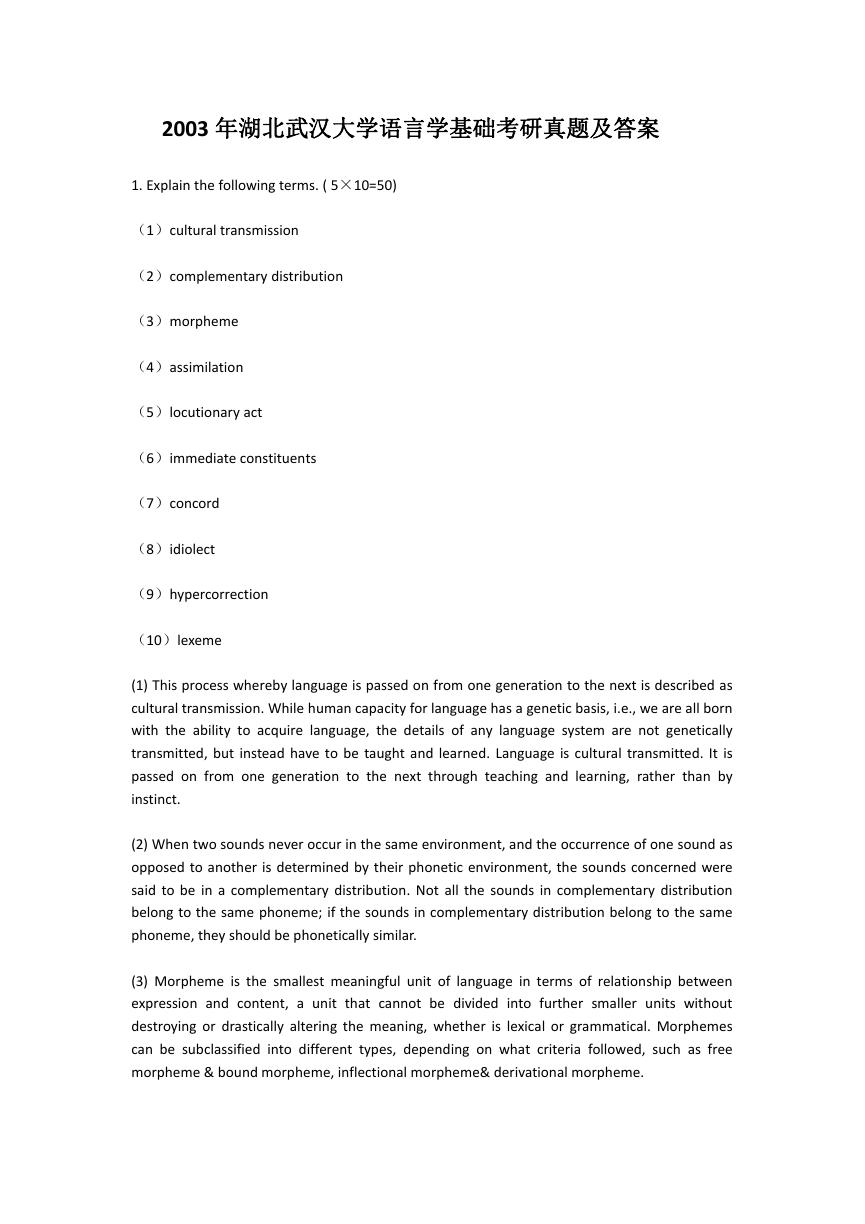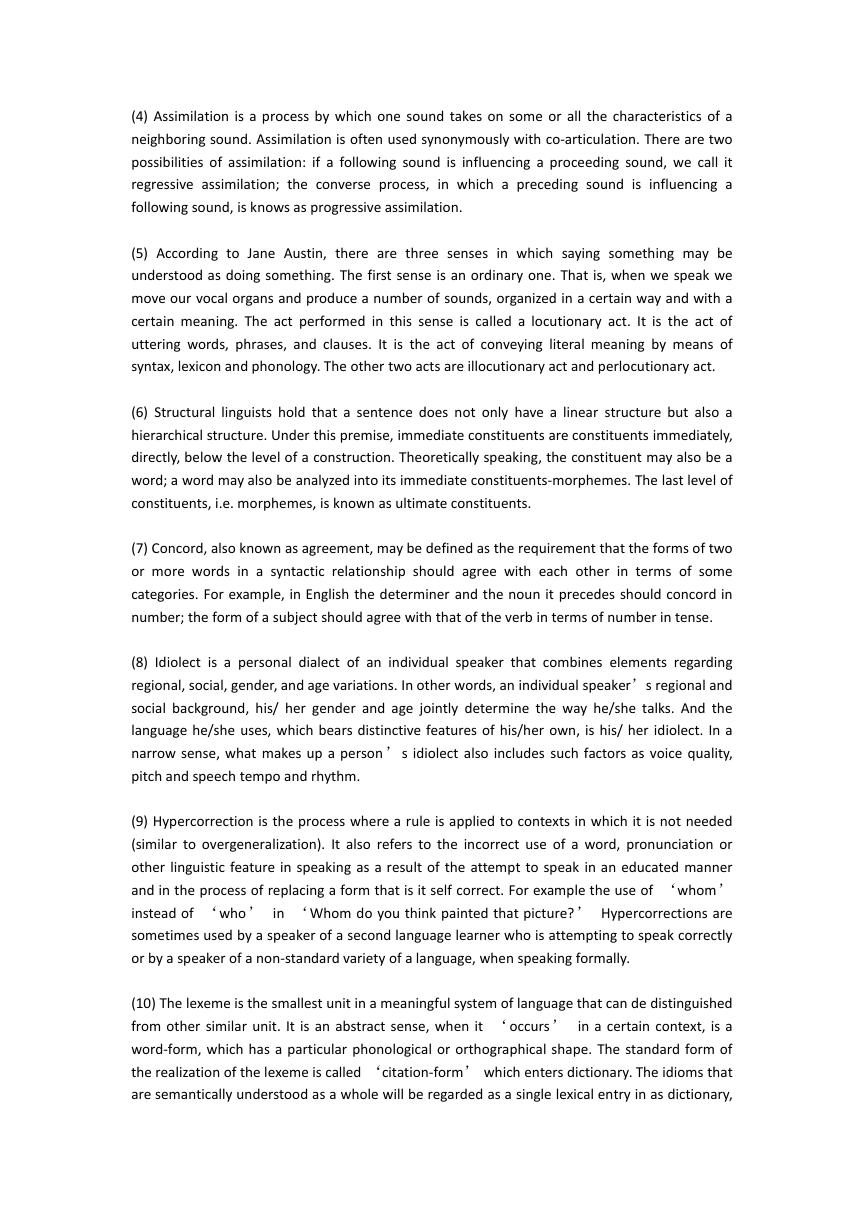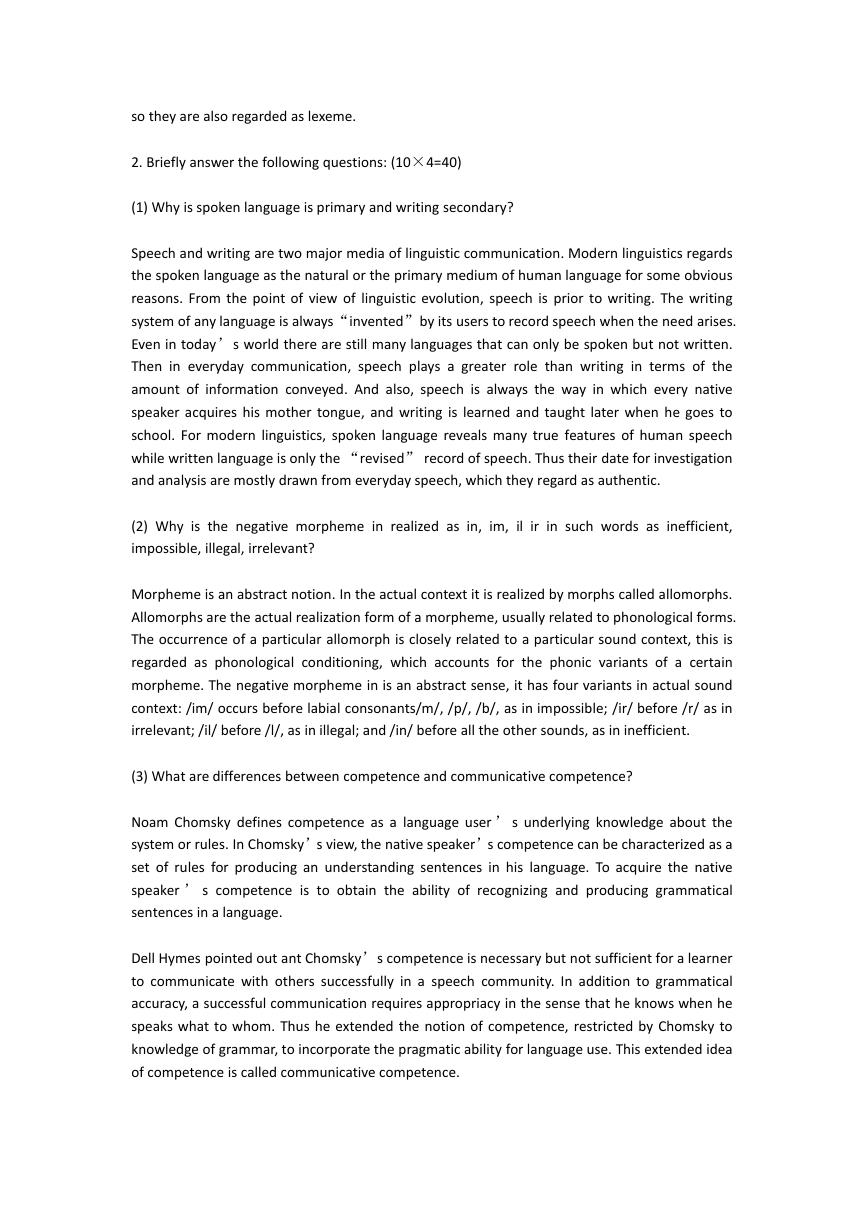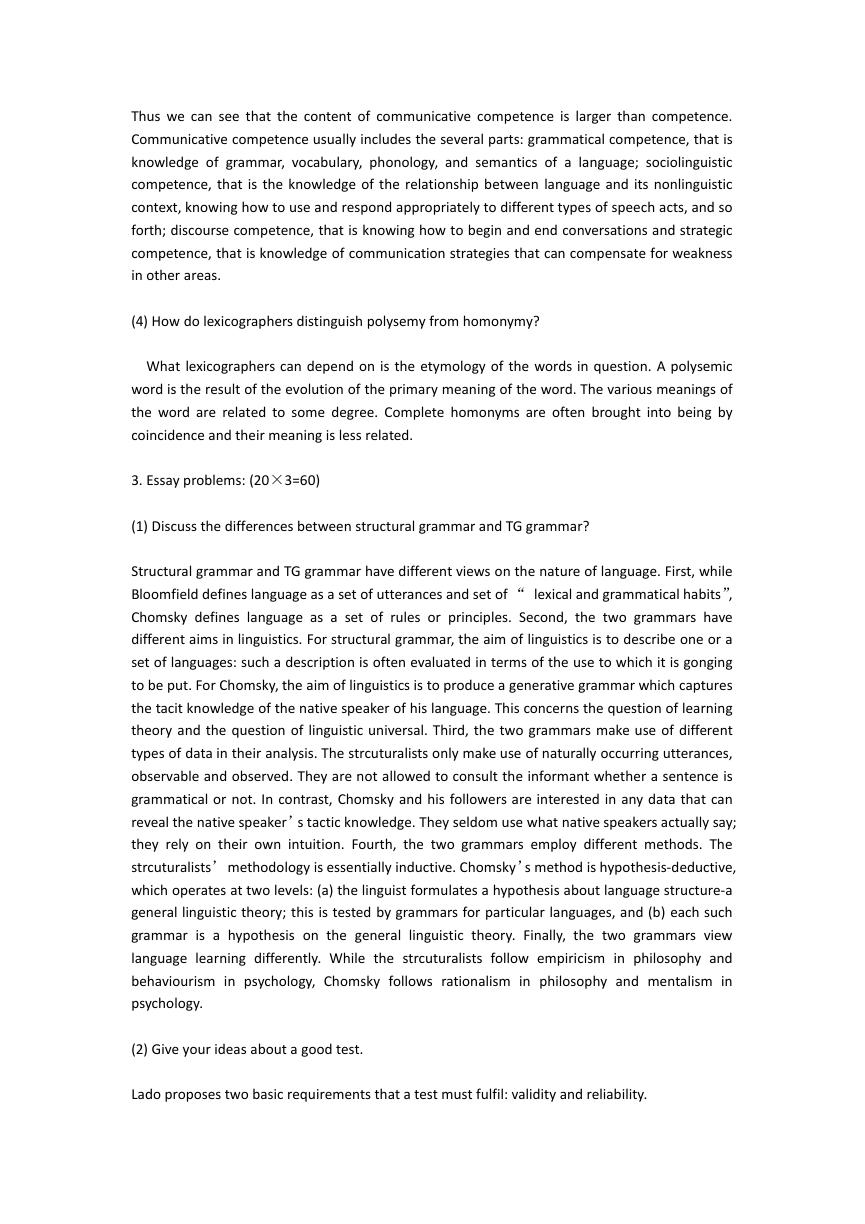2003 年湖北武汉大学语言学基础考研真题及答案
1. Explain the following terms. ( 5×10=50)
(1)cultural transmission
(2)complementary distribution
(3)morpheme
(4)assimilation
(5)locutionary act
(6)immediate constituents
(7)concord
(8)idiolect
(9)hypercorrection
(10)lexeme
(1) This process whereby language is passed on from one generation to the next is described as
cultural transmission. While human capacity for language has a genetic basis, i.e., we are all born
with the ability to acquire language, the details of any language system are not genetically
transmitted, but instead have to be taught and learned. Language is cultural transmitted. It is
passed on from one generation to the next through teaching and learning, rather than by
instinct.
(2) When two sounds never occur in the same environment, and the occurrence of one sound as
opposed to another is determined by their phonetic environment, the sounds concerned were
said to be in a complementary distribution. Not all the sounds in complementary distribution
belong to the same phoneme; if the sounds in complementary distribution belong to the same
phoneme, they should be phonetically similar.
(3) Morpheme is the smallest meaningful unit of language in terms of relationship between
expression and content, a unit that cannot be divided into further smaller units without
destroying or drastically altering the meaning, whether is lexical or grammatical. Morphemes
can be subclassified into different types, depending on what criteria followed, such as free
morpheme & bound morpheme, inflectional morpheme& derivational morpheme.
�
(4) Assimilation is a process by which one sound takes on some or all the characteristics of a
neighboring sound. Assimilation is often used synonymously with co-articulation. There are two
possibilities of assimilation: if a following sound is influencing a proceeding sound, we call it
regressive assimilation; the converse process,
in which a preceding sound is influencing a
following sound, is knows as progressive assimilation.
(5) According to Jane Austin, there are three senses in which saying something may be
understood as doing something. The first sense is an ordinary one. That is, when we speak we
move our vocal organs and produce a number of sounds, organized in a certain way and with a
certain meaning. The act performed in this sense is called a locutionary act. It is the act of
uttering words, phrases, and clauses. It is the act of conveying literal meaning by means of
syntax, lexicon and phonology. The other two acts are illocutionary act and perlocutionary act.
(6) Structural linguists hold that a sentence does not only have a linear structure but also a
hierarchical structure. Under this premise, immediate constituents are constituents immediately,
directly, below the level of a construction. Theoretically speaking, the constituent may also be a
word; a word may also be analyzed into its immediate constituents-morphemes. The last level of
constituents, i.e. morphemes, is known as ultimate constituents.
(7) Concord, also known as agreement, may be defined as the requirement that the forms of two
or more words in a syntactic relationship should agree with each other in terms of some
categories. For example, in English the determiner and the noun it precedes should concord in
number; the form of a subject should agree with that of the verb in terms of number in tense.
(8) Idiolect is a personal dialect of an individual speaker that combines elements regarding
regional, social, gender, and age variations. In other words, an individual speaker’s regional and
social background, his/ her gender and age jointly determine the way he/she talks. And the
language he/she uses, which bears distinctive features of his/her own, is his/ her idiolect. In a
narrow sense, what makes up a person ’s idiolect also includes such factors as voice quality,
pitch and speech tempo and rhythm.
(9) Hypercorrection is the process where a rule is applied to contexts in which it is not needed
(similar to overgeneralization). It also refers to the incorrect use of a word, pronunciation or
other linguistic feature in speaking as a result of the attempt to speak in an educated manner
and in the process of replacing a form that is it self correct. For example the use of ‘whom’
instead of ‘who’ in ‘Whom do you think painted that picture?’ Hypercorrections are
sometimes used by a speaker of a second language learner who is attempting to speak correctly
or by a speaker of a non-standard variety of a language, when speaking formally.
(10) The lexeme is the smallest unit in a meaningful system of language that can de distinguished
from other similar unit. It is an abstract sense, when it ‘occurs ’ in a certain context, is a
word-form, which has a particular phonological or orthographical shape. The standard form of
the realization of the lexeme is called ‘citation-form’ which enters dictionary. The idioms that
are semantically understood as a whole will be regarded as a single lexical entry in as dictionary,
�
so they are also regarded as lexeme.
2. Briefly answer the following questions: (10×4=40)
(1) Why is spoken language is primary and writing secondary?
Speech and writing are two major media of linguistic communication. Modern linguistics regards
the spoken language as the natural or the primary medium of human language for some obvious
reasons. From the point of view of linguistic evolution, speech is prior to writing. The writing
system of any language is always“invented”by its users to record speech when the need arises.
Even in today’s world there are still many languages that can only be spoken but not written.
Then in everyday communication, speech plays a greater role than writing in terms of the
amount of information conveyed. And also, speech is always the way in which every native
speaker acquires his mother tongue, and writing is learned and taught later when he goes to
school. For modern linguistics, spoken language reveals many true features of human speech
while written language is only the “revised” record of speech. Thus their date for investigation
and analysis are mostly drawn from everyday speech, which they regard as authentic.
(2) Why is the negative morpheme in realized as in, im, il
impossible, illegal, irrelevant?
ir in such words as inefficient,
Morpheme is an abstract notion. In the actual context it is realized by morphs called allomorphs.
Allomorphs are the actual realization form of a morpheme, usually related to phonological forms.
The occurrence of a particular allomorph is closely related to a particular sound context, this is
regarded as phonological conditioning, which accounts for the phonic variants of a certain
morpheme. The negative morpheme in is an abstract sense, it has four variants in actual sound
context: /im/ occurs before labial consonants/m/, /p/, /b/, as in impossible; /ir/ before /r/ as in
irrelevant; /il/ before /l/, as in illegal; and /in/ before all the other sounds, as in inefficient.
(3) What are differences between competence and communicative competence?
Noam Chomsky defines competence as a language user ’ s underlying knowledge about the
system or rules. In Chomsky’s view, the native speaker’s competence can be characterized as a
set of rules for producing an understanding sentences in his language. To acquire the native
speaker ’ s competence is to obtain the ability of recognizing and producing grammatical
sentences in a language.
Dell Hymes pointed out ant Chomsky’s competence is necessary but not sufficient for a learner
to communicate with others successfully in a speech community. In addition to grammatical
accuracy, a successful communication requires appropriacy in the sense that he knows when he
speaks what to whom. Thus he extended the notion of competence, restricted by Chomsky to
knowledge of grammar, to incorporate the pragmatic ability for language use. This extended idea
of competence is called communicative competence.
�
Thus we can see that the content of communicative competence is larger than competence.
Communicative competence usually includes the several parts: grammatical competence, that is
knowledge of grammar, vocabulary, phonology, and semantics of a language; sociolinguistic
competence, that is the knowledge of the relationship between language and its nonlinguistic
context, knowing how to use and respond appropriately to different types of speech acts, and so
forth; discourse competence, that is knowing how to begin and end conversations and strategic
competence, that is knowledge of communication strategies that can compensate for weakness
in other areas.
(4) How do lexicographers distinguish polysemy from homonymy?
What lexicographers can depend on is the etymology of the words in question. A polysemic
word is the result of the evolution of the primary meaning of the word. The various meanings of
the word are related to some degree. Complete homonyms are often brought into being by
coincidence and their meaning is less related.
3. Essay problems: (20×3=60)
(1) Discuss the differences between structural grammar and TG grammar?
Structural grammar and TG grammar have different views on the nature of language. First, while
Bloomfield defines language as a set of utterances and set of “ lexical and grammatical habits”,
Chomsky defines language as a set of rules or principles. Second, the two grammars have
different aims in linguistics. For structural grammar, the aim of linguistics is to describe one or a
set of languages: such a description is often evaluated in terms of the use to which it is gonging
to be put. For Chomsky, the aim of linguistics is to produce a generative grammar which captures
the tacit knowledge of the native speaker of his language. This concerns the question of learning
theory and the question of linguistic universal. Third, the two grammars make use of different
types of data in their analysis. The strcuturalists only make use of naturally occurring utterances,
observable and observed. They are not allowed to consult the informant whether a sentence is
grammatical or not. In contrast, Chomsky and his followers are interested in any data that can
reveal the native speaker’s tactic knowledge. They seldom use what native speakers actually say;
they rely on their own intuition. Fourth, the two grammars employ different methods. The
strcuturalists’methodology is essentially inductive. Chomsky’s method is hypothesis-deductive,
which operates at two levels: (a) the linguist formulates a hypothesis about language structure-a
general linguistic theory; this is tested by grammars for particular languages, and (b) each such
grammar is a hypothesis on the general
linguistic theory. Finally, the two grammars view
language learning differently. While the strcuturalists follow empiricism in philosophy and
behaviourism in psychology, Chomsky follows rationalism in philosophy and mentalism in
psychology.
(2) Give your ideas about a good test.
Lado proposes two basic requirements that a test must fulfil: validity and reliability.
�
A. Validity is the degree to which a test measures what it is meant to measure. There are several
kinds of validity:
(a) Content validity. It refers to the extent to which the test adequately covers the syllabus area
to be tested. It can be affected by the length, selection of topics, and some other factors of the
test.
(b) Construct validity. It the test proves the theoretical construct on which it is based, it can be
said to have construct validity.
(c) Empirical validity. If the results of test correlate with some external criteria, the test can be
said to possess empirical validity. Empirical validity can be “concurrent ”, when test results
match the results of other valid tests or independent measures or “predictive ”, when test
results correspond with another criterion.
(d) Face validity. Unlike the other three forms of validity, face validity is based on the subjective
judgement of an observer. If the test appears to be measuring what it intends to measure, the
test is considered to have face validity.
B. Reliability
Reliability can be defined as consistency. If a test produces the same or very similar results when
given to the same candidates twice in succession or marked by different people, it is regarded as
having high degree of reliability.
Reliability can be affected by two kinds of error. The extrinsic sources of error consist of the
variability of the testers and testees, and the variability of the test situation. The intrinsic sources
of error are within the test itself. These occur when there is a lack of stability or equivalence.
(a) Stability reliability. A measuring device is stable if it gives the same reading when used twice
on the same object, assuming there is no change in the object between the two measurements.
(b) Equivalence reliability. A measuring device is equivalent to another if they produce the same
results when used on the same objects.
(3) Discuss the relationship between language and culture.
In terms of relationship between language and culture, we can infer that a language not only
expresses facts, ideas, or events that represent similar world knowledge by its people, but also
reflects the people ’s attitudes, beliefs, world outlooks, and etc. Language expresses cultural
reality. On the other hand, as people’s language uses express their culture represented by its
social conventions, norms and social appropriateness, the culture both emancipates and
constrains people socially, historically and metaphorically. Sharing a same community culture,
�
people have acquired common ways of viewing the world through their speech interactions with
other members of the same group. Although language and culture are inextricably intertwined,
culture is a wider system that completely includes language as a subsystem. The knowledge and
beliefs that constitute a people ’ s culture are habitually encoded and transmitted in the
language of the people. Language as an integral part of human being, permeates his thinking
and way of viewing the world, language both expresses and embodies cultural reality.
�












 2023年江西萍乡中考道德与法治真题及答案.doc
2023年江西萍乡中考道德与法治真题及答案.doc 2012年重庆南川中考生物真题及答案.doc
2012年重庆南川中考生物真题及答案.doc 2013年江西师范大学地理学综合及文艺理论基础考研真题.doc
2013年江西师范大学地理学综合及文艺理论基础考研真题.doc 2020年四川甘孜小升初语文真题及答案I卷.doc
2020年四川甘孜小升初语文真题及答案I卷.doc 2020年注册岩土工程师专业基础考试真题及答案.doc
2020年注册岩土工程师专业基础考试真题及答案.doc 2023-2024学年福建省厦门市九年级上学期数学月考试题及答案.doc
2023-2024学年福建省厦门市九年级上学期数学月考试题及答案.doc 2021-2022学年辽宁省沈阳市大东区九年级上学期语文期末试题及答案.doc
2021-2022学年辽宁省沈阳市大东区九年级上学期语文期末试题及答案.doc 2022-2023学年北京东城区初三第一学期物理期末试卷及答案.doc
2022-2023学年北京东城区初三第一学期物理期末试卷及答案.doc 2018上半年江西教师资格初中地理学科知识与教学能力真题及答案.doc
2018上半年江西教师资格初中地理学科知识与教学能力真题及答案.doc 2012年河北国家公务员申论考试真题及答案-省级.doc
2012年河北国家公务员申论考试真题及答案-省级.doc 2020-2021学年江苏省扬州市江都区邵樊片九年级上学期数学第一次质量检测试题及答案.doc
2020-2021学年江苏省扬州市江都区邵樊片九年级上学期数学第一次质量检测试题及答案.doc 2022下半年黑龙江教师资格证中学综合素质真题及答案.doc
2022下半年黑龙江教师资格证中学综合素质真题及答案.doc